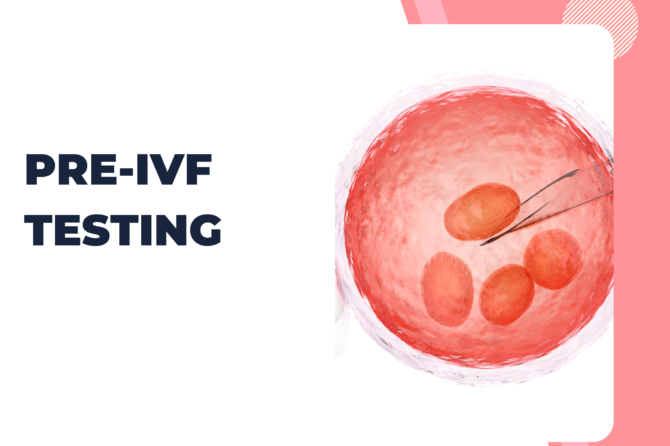
Pre-IVF testing, also known as fertility testing or an infertility workup, is a series of medical evaluations and diagnostic tests performed on both partners prior to IVF. The goal of pre-IVF testing is to identify any potential fertility issues or underlying medical conditions that may interfere with IVF treatment success.
Pre-IVF testing typically includes a thorough medical history review, physical examination, and laboratory testing.
Pre-IVF testing done in Female
Some of the Common Pre-IVF testing are as follows:
Cycle day 3 blood tests for FSH and Estradiol, as well as AMH
- As part of the pre-IVF testing process, cycle day 3 blood tests for FSH (follicle-stimulating hormone), estradiol, and AMH (anti-Mullerian hormone) are commonly performed.
- FSH is a pituitary hormone that plays an important role in the development of follicles in the ovaries, which then produce eggs. The FSH test measures the level of FSH in the blood on cycle day 3, which is the third day of a woman’s menstrual cycle. High FSH levels can indicate a diminished ovarian reserve, which means fewer eggs and a lower chance of conception.
- Estradiol is an oestrogen that is produced by the ovaries. The estradiol test, which measures the level of estradiol in the blood, is also performed on cycle day 3. High levels of estradiol can indicate that the ovaries are already producing follicles, which can make it difficult to stimulate the ovaries properly for IVF.
- AMH is a hormone produced by ovarian follicles that serves as a predictor of ovarian reserve. The AMH test, which measures the level of AMH in the blood, is typically performed at any time during the menstrual cycle. A low AMH level may indicate a depleted ovarian reserve, which may limit the number of eggs that can be retrieved during an IVF cycle.
- Fertility specialists can assess a woman’s ovarian reserve and potential response to IVF treatment by performing these cycle day 3 blood tests. This data is then used to create a personalised treatment plan that increases the chances of a successful pregnancy.
Mid-Cycle Ultrasound
- Mid-cycle ultrasound, also known as follicular monitoring ultrasound, is a type of medical imaging test used to track the development of follicles in a woman’s ovaries during her menstrual cycle. It is typically performed on days 10-12 of the menstrual cycle, which is considered the cycle’s midpoint.
- A transvaginal ultrasound probe is inserted into the vagina and used to produce detailed images of the ovaries and follicles during the procedure. The thickness of the endometrial lining, as well as the size and number of follicles, are measured and recorded.
- Follicular monitoring ultrasound is a useful tool in the pre-IVF testing process because it allows fertility specialists to assess the development of follicles in the ovaries, which contain the eggs that will be retrieved for IVF. The ultrasound results are used to adjust the patient’s medication dosage, medication timing, and egg retrieval procedure timing.
- Fertility specialists can improve the chances of a successful IVF cycle by performing mid-cycle ultrasounds to ensure that the follicles are developing properly and are of optimal size for egg retrieval. This data can also be used to predict the likelihood of multiple pregnancies, which is useful for counselling patients and making informed decisions about how many embryos to transfer during IVF.
Hysterosalpingogram (HSG)
- A hysterosalpingogram (HSG) is a medical imaging test used to assess the health and function of a woman’s uterus and fallopian tubes. It is a type of X-ray in which a contrast dye is used to highlight the reproductive organs and allow doctors to see any blockages, abnormalities, or other issues that may be affecting fertility.
- A thin catheter is inserted through the cervix and into the uterus during the procedure. The uterus is then injected with a contrast dye, which flows through the fallopian tubes. X-ray images are taken as the dye moves through the reproductive tract to document its progress and any blockages or abnormalities that may be present.
- A hysterosalpingogram is usually done during the first half of a woman’s menstrual cycle, just before ovulation. It can aid in the diagnosis of a variety of fertility-related conditions, such as uterine fibroids, polyps, or adhesions, as well as tubal blockages or abnormalities.
- The HSG results can be useful to fertility specialists during the pre-IVF testing process. In some cases, blockages or abnormalities discovered during the HSG can be treated with minimally invasive procedures such as hysteroscopy or laparoscopy to increase the likelihood of a successful IVF cycle.
Hysterosonogram
- A Hysterosonogram is a type of ultrasound test used to assess the health of the uterus. It is also known as a saline sonogram or sonohysterogram.
- A sterile saline solution is injected into the uterus via a small catheter inserted into the cervix during a Hysterosonogram. The saline solution helps to expand the uterine cavity, making any abnormalities easier to see. The uterus is then imaged using an ultrasound probe, allowing the doctor to look for any growths, adhesions, or other abnormalities.
- The results of a Hysterosonogram can be useful to fertility specialists during the pre-IVF testing process. Uterine abnormalities discovered during the test may be treatable with minimally invasive procedures such as hysteroscopy, increasing the likelihood of a successful IVF cycle.
Hysteroscopy
Hysteroscopy is a minimally invasive diagnostic and surgical procedure that allows doctors to examine and treat various conditions inside the uterus. It is usually done as part of pre-IVF testing to detect and treat any underlying uterine abnormalities that may interfere with fertility.
A thin, lighted tube with a camera on the end (called a hysteroscope) is inserted into the uterus through the cervix during a hysteroscopy. The camera allows the doctor to see the inside of the uterus on a monitor and identify any abnormalities like polyps, fibroids, or adhesions.
If an abnormality is discovered, the doctor may remove or correct it with special instruments during the same procedure. This may include the removal of polyps or fibroids, the cutting of adhesions, or the resection of uterine fibroids.
The following are some of the tests performed prior to the IVF procedure. While these are performed on women, men must also undergo testing to ensure the viability of their sperm.
Pre-IVF test done in Male
Some of the most common male tests include:
- Semen Analysis
- Hormone analysis
- Genetic analysis
- Imaging examinations
As a result, the blog concludes here with all of the important information about male and female Pre-IVF testing. These tests ensure that the IVF process runs smoothly throughout the semester and that the procedure is successful.
Because of their unique equipment and techniques of highly skilled doctors, American technology has been deemed the best when it comes to IVF. Allow MediPocket USA to introduce you to the real world of premium healthcare in the United States. Register now to find out more.










Leave a reply